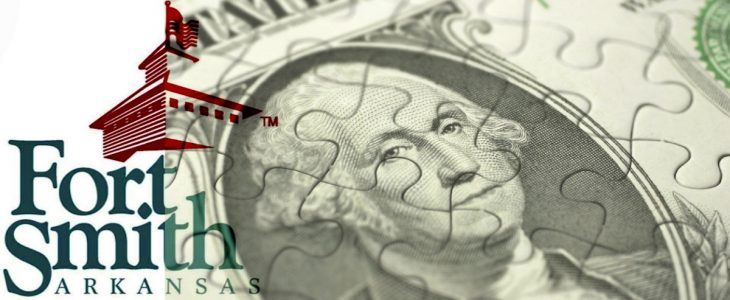Fort Smith sales tax revenue beats budget expectations, but budget cuts to remain
by August 28, 2020 11:59 am 990 views

Revenue from Fort Smith’s portion of the Sebastian County 1% tax for the year is $10.395 million, up a surprising 4.3%, according to the city’s July report. Year-to-date collections from the tax is up 2.37% over the budget estimate.
Year-to-date revenue from the 1% city street tax totaled $12.938 million through the July report, up 2.5% compared with the same period in 2019, and 1.24% – or $265,076 – above the budget estimate.
In the July report, which measures May transactions, the city collected $1.628 million from its portion of the countywide tax, up 11.39% from the budget estimate and up 11.6% compared with revenue in the same period of 2019. The July report shows the 1% street tax revenue at $2.028 million, up 8.8% from the budget estimate and up 10.1% compared with the same period in 2019.
The revenue gain from the countywide tax – which supports the city’s general fund, including fire, police and other critical services – has put an unexpected $409,684 in city coffers but does not mean the city will soon unwind budget cuts. Earlier this year, city departments were asked to trim 10% from each of their budgets. Those cuts will remain in place, said City Administrator Carl Geffken.
“We’re not going to pull back from the budget reductions. … All the things are looking great at the moment” but the next months are uncertain because enhanced unemployment insurance benefits were not extended, Geffken said.
Unemployment insurance benefits that provided an extra $600 a week and paid benefits to the self-employed, fully paid by the federal government, expired at the end of July. Congressional leaders have yet to compromise on legislation to extend and adjust the benefits. President Donald Trump on Aug. 8 issued an executive order that would support extension of jobless benefits. However, it could be weeks, according to Gov. Asa Hutchinson, before the $300 a week in extra unemployment benefits will be received by qualified Arkansans.
Mervin Jebaraj, economist and director of the Center for Business and Economic Research and the University of Arkansas, recently said some credit for gains in sales and use tax revenue – consumer spending – must go to federal relief programs Congress approved earlier this year. Without the certainty of a new stimulus or benefits similar to those that expired, Geffken said the economy remains in “unchartered territory” and city officials aren’t likely to reverse course on budget cuts until economic conditions become more clear.
REGIONAL COLLECTIONS
Sales tax revenue for the first six reporting months of 2020 is up in four counties in the Fort Smith metro compared to the same period in 2019. Following are sales tax revenue numbers for four counties and selected cities within the Fort Smith metro through the first half of 2020, which is the most recent data available from the Arkansas Department of Finance and Administration.
Crawford County
Jan.-June 2020: $7.349 million
Jan.-June 2019: $6.461 million
up 13.7%
Van Buren
Jan.-June 2020: $3.545 million
Jan.-June 2019: $4.182 million
down 15.2%
Franklin County
Jan.-June 2020: $1.989 million
Jan.-June 2019: $1.863 million
up 6.8%
Logan County
Jan.-June 2020: $2.578 million
Jan.-June 2019: $2.324 million
up 10.9%
Sebastian County
Jan.-June 2020: $16.378 million
Jan.-June 2019: $15.529 million
up 5.5%
Greenwood
Jan.-June 2020: $1.595 million
Jan.-June 2019: $1.354 million
up 17.8%
PREVIOUS ANNUAL COLLECTION INFO
Fort Smith 1% sales tax collection for streets
2019: $21.73 million
2018: $21.503 million
2017: $21.204 million
2016: $21.156 million
2015: $20.308 million
Fort Smith portion of 1% countywide sales tax
2019: $17.265 million
2018: $17.043 million
2017: $16.691 million
2016: $16.58 million
2015: $16.09 million
